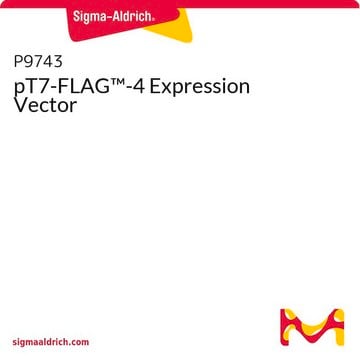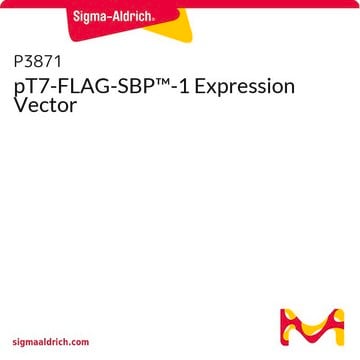P1118
pT7-FLAG™-1 Expression Vector
Autenticatiper visualizzare i prezzi riservati alla tua organizzazione & contrattuali
About This Item
Codice UNSPSC:
12352200
Prodotti consigliati
Grado
for molecular biology
Stato
buffered aqueous solution
Condizioni di spedizione
dry ice
Temperatura di conservazione
−20°C
Descrizione generale
pT7-FLAG™-2 is a 4.8 kb E . coli expression vector used for cloning and cytoplasmic expression of a properly inserted open reading frame as a N-terminal Met-FLAG fusion protein containing the FLAG® epitope (DYKDDDDK). The promoter region of the very strong phage T7 promoter drives transcription of ORFFLAG fusion constructs. This vector requires the use of E. coli cells containing a source of the T7 polymerase, such as BL21(DE3)T1R cells, Catalog Number B2935.
Applicazioni
pT7-FLAG®-1 Expression Vector has been used in the cloning of ubiquitin fusion protein and connexin 43 (Cx43) C-terminal fragment.
Componenti
pT7-FLAG™-1 Expression Vector (P6742) is supplied as 0.5 mg/ml in 10 mM Tris-HCl (pH 8.0) with 1 mM EDTA.
pT7-FLAG™-1-BAP Control Vector (P6992) is supplied as 0.5 mg/ml in 10 mM Tris-HCl (pH 8.0) with 1 mM EDTA.
pT7-FLAG™-1-BAP Control Vector (P6992) is supplied as 0.5 mg/ml in 10 mM Tris-HCl (pH 8.0) with 1 mM EDTA.
Note legali
FLAG is a registered trademark of Merck KGaA, Darmstadt, Germany
pT7-FLAG is a trademark of Sigma-Aldrich Co. LLC
Prodotti correlati
N° Catalogo
Descrizione
Determinazione del prezzo
Codice della classe di stoccaggio
12 - Non Combustible Liquids
Scegli una delle versioni più recenti:
Certificati d'analisi (COA)
Lot/Batch Number
Non trovi la versione di tuo interesse?
Se hai bisogno di una versione specifica, puoi cercare il certificato tramite il numero di lotto.
Possiedi già questo prodotto?
I documenti relativi ai prodotti acquistati recentemente sono disponibili nell’Archivio dei documenti.
Chase T Archer et al.
The Journal of biological chemistry, 283(31), 21789-21798 (2008-06-03)
Destabilization of activator-DNA complexes by the proteasomal ATPases can inhibit transcription by limiting activator interaction with DNA. Modification of the activator by monoubiquitylation protects the activator from this destabilization activity. In this study, we probe the mechanism of this protective
Alasdair I Macdonald et al.
The Biochemical journal, 446(1), 9-21 (2012-06-05)
Gap junctions, composed of Cxs (connexins), allow direct intercellular communication. Gap junctions are often lost during the development of malignancy, although the processes behind this are not fully understood. Cx43 is a widely expressed Cx with a long cytoplasmic C-terminal
Yo Sugawara et al.
The Journal of cell biology, 189(4), 691-700 (2010-05-12)
Botulinum neurotoxin is produced by Clostridium botulinum and forms large protein complexes through associations with nontoxic components. We recently found that hemagglutinin (HA), one of the nontoxic components, disrupts the intercellular epithelial barrier; however, the mechanism underlying this phenomenon is
Ning Kong et al.
Autophagy, 16(10), 1737-1752 (2019-12-24)
Interferon-induced BST2 (bone marrow stromal cell antigen 2) inhibits viral replication by tethering enveloped virions to the cell surface to restrict viral release and by inducing the NFKB-dependent antiviral immune response. However, the mechanism by which BST2 uses the selective
Il team dei nostri ricercatori vanta grande esperienza in tutte le aree della ricerca quali Life Science, scienza dei materiali, sintesi chimica, cromatografia, discipline analitiche, ecc..
Contatta l'Assistenza Tecnica.





